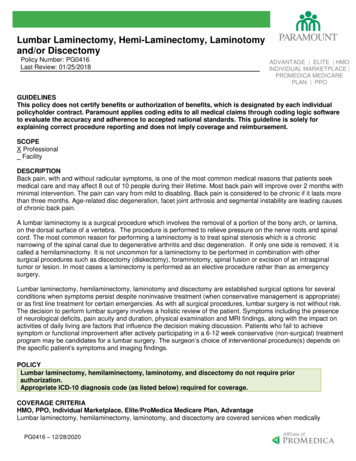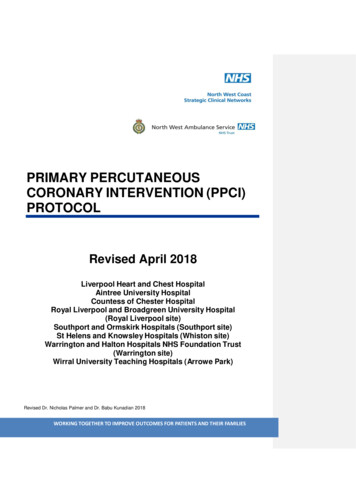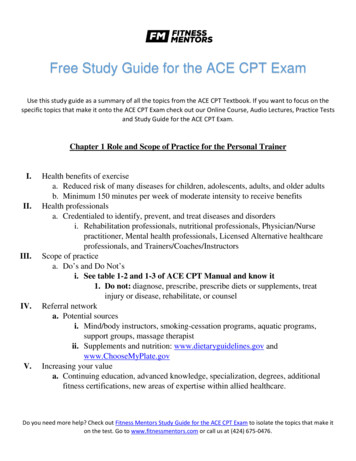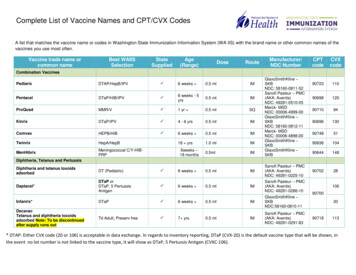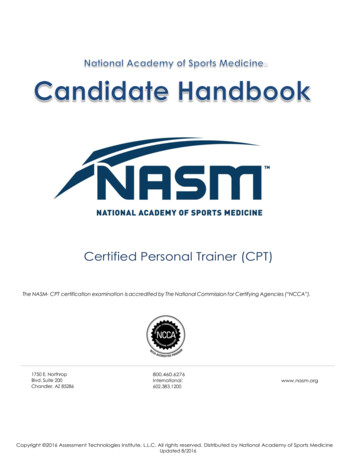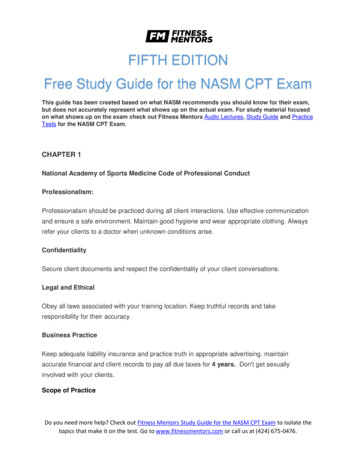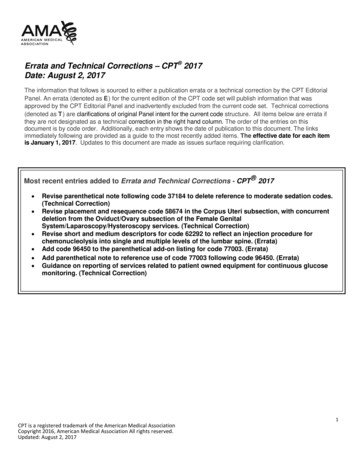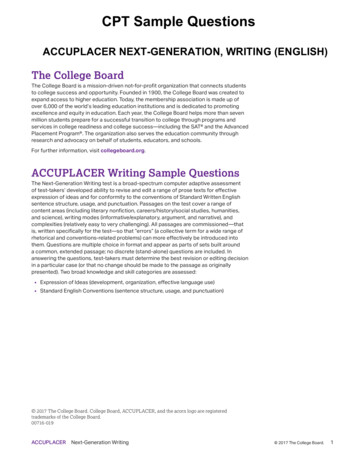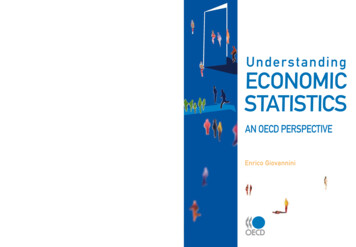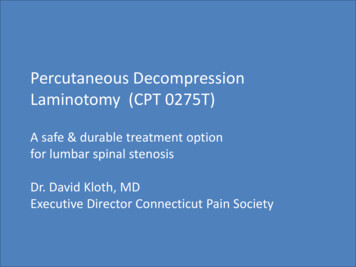
Transcription
Percutaneous DecompressionLaminotomy (CPT 0275T)A safe & durable treatment optionfor lumbar spinal stenosisDr. David Kloth, MDExecutive Director Connecticut Pain Society
Disclosures No financial or ownership relationship to anycompany involved (currently or future) with productconnected to this procedure BOD ASIPP Ex. Dir. CPS President-Elect NANS Ex-CAC rep for CT Assisted in the development of LCD’s on manyoccasions NANS representative on the MPW
Procedure Overview
Lumbar Spinal Stenosis (LSS) No pressure on spinal cord Mobile/flexible No symptoms (pain, numbness, tingling)Stenosis creates pressure, causing: Pain, numbness & tingling Weakness with activity Pain relieved by flexion (sitting,leaning, bending) Initial symptom onset generally occurs between 50 – 60 years of age2 Limited therapeutic options, short of open surgery Impacts 1.2M1 Patients in U.S.¹Longitudinal Medicare Database, Quorum Consulting2Birmeyer NJ, Weinstein JN. Medical versus surgical treatment for low back pain: evidence and clinical practice. Eff Clin Pract. 1999;2:218-227
LSS Symptoms – A Need For Differentiating the Cause94% of LSS patients3Neurogenic Claudication(NC) Thecal saccompression / ischemia1,2Radicular Pain (RP) Nerve root inflammation1Different pathophysiological causes1 require different treatments Epidural Steroid Injections treat inflammation NOT ischemia. Decompression is required to treat thecal sac compression/ischemia.M et al., Symptoms of Spinal Stenosis Do Not Improve After Epidural Steroid Injection. Clinical Journal of Pain: 6/1998;14(2):148-151.RW, Spinal stenosis & neurogenic claudication. Spine 1996 Sep 1; 21(17): 2046-52.3Hall S, Bartleson JD, Onofrio BM, Baker HL, Okazaki H, O’Duffy JD. Lumbar spinal stenosis. Clinical features, diagnostic procedures, and results of surgical treatment in 68 patients. Ann Intern Med 1985;103(2):271-5.1Fukusaki,2Porter
LSS Treatment OptionsMore InvasiveConservative Therapy:Physical terspinousSpacersFusionLess InvasiveMore InvasivePercutaneous Decompression Laminotomy achieves the safety profile of conservative treatments with the efficacy of therapeutic treatments.
Neurogenic Claudication Treatments:Percutaneous Decompression Laminotomy CandidatePercutaneous Decompression Laminotomy Candidate: Percutaneous DecompressionLaminotomy is an optionOpen Surgerywhen hypertrophic ligamentumCandidateflavum is a predominantfactor of LSS Removal of a small amount of tissue, 1-2 mm, can resultin a significant increase in the size of the spinal canalsq.area 𝜋𝜋 2
Percutaneous Decompression Laminotomy:Introduction A safe procedure that can help LSS patients stand longer &walk farther with less pain1 Treats lumbar spinal stenosis (LSS) with neurogenicclaudication Approximately 13,000 patients treated in over 45 states FDA 510(k) Cleared Devices– “Intended to be used to perform lumbar decompressive procedures for thetreatment of various spinal conditions” CPT Category III: 0275T– Percutaneous laminotomy/laminectomy (interlaminar approach) fordecompression of neural elements, (with or without ligamentous resection,discectomy, facetectomy and/or foraminotomy) any method under indirectimage guidance (e.g., fluoroscopic, CT), with or without the use of anendoscope, single or multiple levels, unilateral or bilateral; lumbar1Mekhail, Nagy, et al. (2012) Functional and Patient-Reported Outcomes in Symptomatic Lumbar Spinal Stenosis Following Percutaneous Decompression. Pain Practice, 12(6): 417–425. doi:10.1111/j.1533-2500.2012.00565.
Percutaneous Decompression Laminotomy:Procedure Description FDA cleared devices, fluoroscopically guided, safe, outpatient procedure for the treatment of LSS: Performed through a small portal (5.1 mm) Requires NO general anesthesia, NO stitches, & NO overnight hospital stay Limited tissue available to be removed (minimal return of ligament in Tissue Sculpter) Changes noted in epidurogram (improved / easier flow, thicker / straighter line) Epidurogram reveals space restoration in debulked / previously stenosed areaPre-procedurePost-procedure
Percutaneous DecompressionThrough a 5.1 mm PortalDebulk the Ligamentum Flavum Debulking restores space in the spinal canalAccess minimizes tissue disruptionRemoval of a small portion of laminaRemoval of excess ligamentum flavumLeaves anterior ventral fibers of the ligament intactSupporting structures remain intact(spinous process, facets, & majority of lamina)EpidurogramDecompressionProcedure Area
Percutaneous Decompression Laminotomy &Open Surgery Comparison1BasedBenefits of PercutaneousDecompressionLaminotomyLaminotomy/ Laminectomy(with or without Fusion)Percutaneous DecompressionLaminotomyProcedure Setting/AnesthesiaInpatient:General AnesthesiaOutpatient:MACIncision Length2–5 InchesStitches5.1 MillimetersNo StitchesDays in Hospital3–5(2) 1Complication RateDural Tear / Blood LossRequiring Transfusion23.5%(3)0.06% Commercial Cases0% In All Clinical Trials(1)Responder Rate60–80%(4)70 –80%(1)Comparable EfficacyAverage MedicareReimbursement 20 –80K(4) 4,760(5)Low CostSafe by DesignLow ComplicationRiskon procedure data collected in all clinical trials.Mizra, Martin, Kreuter, Goodman, Jarvik. Trends, Major Medical Complications, & Charges Associated With Surgery for Lumbar Spinal Stenosis in Older Adults. JAMA, Vol. 303 No. 13.et al., for the SPORT Investigators. Surgical vs. Nonsurgical Therapy for LSS. New Engl J Med. 2008;358:794–810. 9.2% dural tear & 14.3% blood loss requiring transfusion reported.4Weinstein, et al., for the SPORT Investigators. Surgical vs. Nonsurgical Therapy for LSS. New Engl J Med. 2008;358:794–81052013 Medicare National Average Reimbursement for APC 0208 is 3,760, Physician Fees are Carrier priced and average at 1000 per procedure2Deyo,3Weinstein,
Clinical Data Overview
Robust Clinical Research 16 Published Peer-Reviewed Journal Articles 11 Clinical Trials, including 542 Patients:–––––––––––Safety SeriesMiDAS IMiDAS IIMiDAS ECOSurgery IntolerantPercutaneous Decompression Laminotomy vs. ESISingle-Site SeriesCleveland Clinic StudySingle-Site Long Term SeriesIndependent Case Series with 1 Year Follow-upProspective Single-Site Month 6 Report
Peer Reviewed Clinical Literature Demonstrates Safety& Improved Patient OutcomesStudy Author/ AbbreviatedTitle# PLDPatientsMilestoneStudy Design SummaryOutcomes-VAS improvement-ODI improvementZCQ Outcomes-Symptom (S)-Function (F)-SatisfactionMekhail et al/ FunctionalOutcomes Long TermN 40Year 1Prospective single centerEndpoints: VAS, Roland Morris (RM),PDI (Pain Disability Index), StandingTime (ST), Walking Distance (WD)Chopko & Caraway/ MiDASPhase IN 75Week 6Prospective 14 study centers EndpointsVAS, ODI, ZCQ.SF-12v2 VAS 3.6 (p 0.0001, t-test)ODI 17.9 (p 0.0001, t-test)Lingreen & Grider/ Post-mildReportN 42Month 1Retrospective Single CenterEndpoints: VAS, Standing Time,Walking Time, SatisfactionVAS 3.8 (p 0.05, Mann-Whitney Utest)Mekhail, et al./mild LongTerm ResultsN 58Year 1Prospective, 11 study centersEndpoints: VAS, ODI, ZCQ, SF-12v2VAS 2.9 (p 0.0001, t-test)ODI 11.9 (p 0.0001, t-test)Chopko/High Risk PatientsN 14 Month 8Prospective controlled single centerEndpoints: VAS, ODIVAS 3.9 (p 0.05, ANOVA) ODI 17.2(p 0.05, ANOVA)Brown / RCT ESI vs mildN 38Month 3Prospective controlled single centerEndpoints: VAS, ODI, ZCQ SatisfactionVAS 2.9 (p 0.01 Tukey HSD)ODI 18.6(p 0.01Tukey HSD)N 27Month 6N 253Month 3Prospective controlled single centerEndpoints: VAS, ODI, ZCQMeta-analysis, 17 study centersEndpoints: VAS, ODIVAS 5.2 (p 0.0001, t-test) ODI 24.0(p 0.0004,t-test)VAS 3.5 (p 0.0001, t-test) ODI 17.1(p 0.0001 t-test)Prospective controlled single centerEndpoints: VAS, ODIVAS 5.4 (95% CI 1.5)(95% CI 8.8)VAS 2.9 (p 0.0001,ANOVA) ODI17.4(p 0.0001,ANOVA)Basu /Single Site SeriesSchomer/mild lumbarDecompressionWong/ InterlaminarDecompression Long TermOutcomesN 171YearVAS 3.5 (p 0.0001, ANOVA)RM 7.7 (54% improvement), p 0.0001 ANOVAPDI 22.6 (55% improvement), p 0.0001 ANOVAST 56 min (570% improvement), p 0.0001 ANOVAWD 3710 ft (1510% improvement), p 0.0001 ANOVAS2.35(p 0.0001, t-test)F1.96(p 0.001, t-test)Satisfaction 2.0Satisfaction 1.8S 1.71(p 0.001, t-test)F 1.17(p 0.001, t-test)Satisfaction 1.8ODI 26.6N 35 Year 1Prospective controlled, single centerEndpoints: VAS, ODI, ZCQLevy, et al./ SystematicReview & Meta-AnalysisN 109 Year1Systematic Review & Meta-analysisEndpoints: VAS, ODIVAS 3.9 (95% CI 0.42) ODI 16.0(95% CI 3.35)N 45 Year 2Prospective 11 study centers EndpointsVAS, ODI, ZCQ.VAS 2.4 (p 0.0001,ANOVA)(p 0.0001,ANOVA)ODI 8.6Note: Clinical relevance was also established in all validated outcomes measures: VAS 2, ODI 6, ZCQ Domains 0.5 Satisfaction 2.5, SF-12v2 PCS 3 points.PCS 9.0 (95% CI 3.02)59% of patients stand longer57% of patients walk longer86% of patients recommended mild to other patientsS 1.16(p 0.001, t-test)F 0.58(p 0.002, t-test)Satisfaction 2.2Deer, et al. / Single Site LongTerm mild ResultsChopko/ Long-term Results –Two Year OutcomesPost PLD improvement-SF 12v2 Physical Component Score (PCS)-OthersS 1.2(p 0.0001,t-test) F0.8(p 0.0001,t-test)Satisfaction 1.86S 0.9(95% CI 0.2)F 0.4(95% CI 0.2)Satisfaction 2.2PCS 6.1 (95% CI 2.99)
Dramatic Functional Improvement at 1 Year1Cleveland Clinic, Prospective, Single-Center StudyWalking distance: 246' to 3,956’Standing time: 8 to 56 minutesImprovement allows patients to perform activitiesof daily living: washing dishes, cooking, groceryshoppingMean Walking Distance at EachFollow-upImproved 570%Walking Distance Mean FeetStanding Time Mean MinutesMean Standing Time at EachFollow-up6050403020N 34100BaselineMonth 3Month 6TimeMonth 9Month 12Aroundthe mallTo themailbox4000Improved 1,510%30002000N 3410000BaselineMonth 3Month 6Month 9Month 12Time1Mekhail, Nagy, et al. (2012) Functional and Patient-Reported Outcomes in Symptomatic Lumbar Spinal Stenosis Following Percutaneous Decompression. Pain Practice, 12(6): 417–425.doi: 10.1111/j.1533-2500.2012.00565.x
Study BackgroundMiDAS I1 Prospective– Year 1 follow-up Multi-center– 11 U.S. study centers Safety– Comprehensive solicited & unsolicited Patient-Reported Outcomes––––1MekhailVAS: 10-point Visual Analog ScaleODI: Oswestry Disability IndexSF-12v2 : Health SurveyZCQ: Zurich Claudication QuestionnaireN, Vallejo R, Coleman MH, Benyamin RM. Long-term results of percutaneous lumbar decompression mild for spinal stenosis. Pain Pract 2012;12(3):184-193.
Year 1 Cohort (N 58)MiDAS IDemographicsAverage Age:70 YearsFemale 65.5%Male 34.5%Length of Stay100 Patients Less than24 HoursPatients Treated / LevelTotal levelstreated 9049431100% Patients33Total Levels / Patient27Patients30Patients89% of levelswere treatedbilaterally1Patient1 Level2 Levels3 Levels
Reduced Pain & Improved MobilityDurable at Year 1ODI Over Time (Responders2)VAS Over Time (Responders1)4 PointMeanImprovementNo PainOswestry Disability Index (ODI)SeverelyLimited16.6 PointMeanImprovement3Mean ODI ScoreVisual Analog Scale (VAS) lly RelevantClinically Relevantof all Year 1 Patients were Responders1 Mean Pain – 53% Reduction Mean Mobility – 34% IncreaseStatistically Significant p 0.0001, t-test 79%Statistically Significant p 0.0001, t-test1Respondersdefined as VAS reductions 1.published approximate MCID for the ODI version utilized in this study is 6.0 (JM Fritz, JJ Irrgang, Physical Therapy February 2001 vol. 81 no. 2 776–788).3Year 1 mean ODI improvement of 16.6 points represents 79% of all year 1 patients (responders).2The
Decompression Required to Treat NCESI vs. Percutaneous Laminotomy Decompression1 Prospective, randomized, double-blind, single-center study 100% of patients had Neurogenic Claudication SymptomsESI866.16.25432.42N 17108*Pre-TxWeek 1 Week 6 Week 12Time7Mean VAS ScoreMean VAS Score7PLD66.3544.133.82.52N 2110Pre-TxWeek 1 Week 6 Week 12Time Only patients treated with PLD experienced long term pain relief from NC symptoms After 6 weeks, patients were unblinded & 100% of patients treated with ESI crossed overto PLD– Crossover patients experienced similar improvement as PLD cohort1Brown,*n 2L. A Double-blind, Randomized, Prospective Study of Epidural Steroid Injection vs. The mild Procedure in Patients with Symptomatic Lumbar Spinal Stenosis. Pain Practice, 2012.as all other patients had crossed over to mild . These 2 patients crossed over to mild after week 12.
Two-Year Outcomes1 Approx. 75% of 1 Year Patients have reported outcomes at 2 years Findings are consistent with 1 year outcomes Published in Clinical Journal of Pain on Feb 26th 20131Chopko,Baseline2 YearMeanImprovementMean VAS(Responders2)7.94.13.8 pointsMean ODI(Responders2)50.538.911.6 pointsB. Long-term Results of Percutaneous Lumbar Decompression for LSS Two-Year Outcomes. Clin J Pain 2013; DOI. 10.1097/AJP.0b013e31827fb803 [Epub ahead of print].defined as VAS reductions 1. Response rate 71.1%.2Responders
Procedure Safety in Clinical Trials:Percutaneous Decompression Laminotomy vs. Open my/Laminectomywith or without FusionNumber of Patients3891394Dural Tear0%9.2%Blood Transfusion0%14.3%OPEN SURGERY2Overall Adverse EventsIntraoperative0%9.9%Postoperative0%12.3%*No major intraoperative or postoperative Percutaneous Decompression Laminotomy device or procedure-related adverse events (bloodloss requiring transfusion, dural tear, hematoma, nerve root damage) reported in any clinical studies. A total of 7 adverse events have beenreported in over 13,000 commercial cases, a rate of 0.06%.11.MiDAS I (78 Patients) 2. Single-Site Series (42 Patients) 3. mild vs. ESI (38 Patients) 4. Safety Series (90 Patients) 5. Single-Site Long Term Series (46 Patients) 6. MiDAS II (55 Patients)7. Cleveland Clin
Exercise Laminotomy Laminectomy Epidural Interspinous Fusion Steroid Spacers . Injections . Less Invasive . Percutaneous Decompression Laminotomy achieves the safety profile of conservative treatments with the efficacy of therapeutic treatments. Percutaneous Decompression Laminotomy Candidate: Neurogenic Claudication Treatments: Percutaneous Decompression Laminotomy
